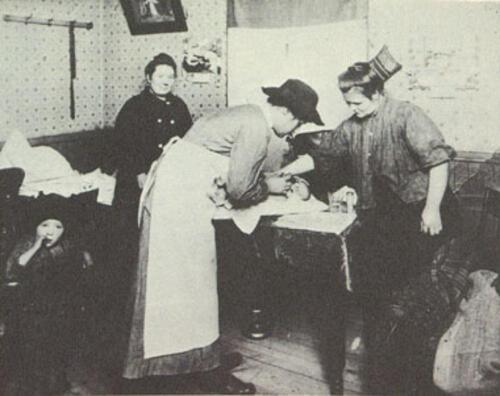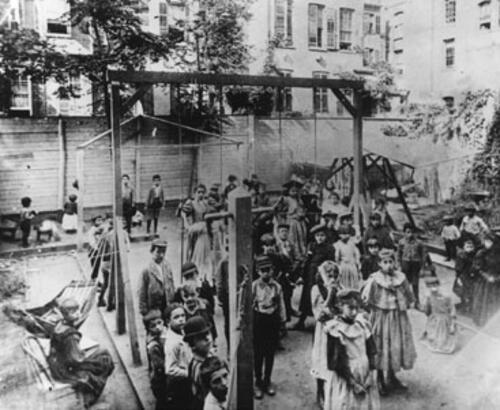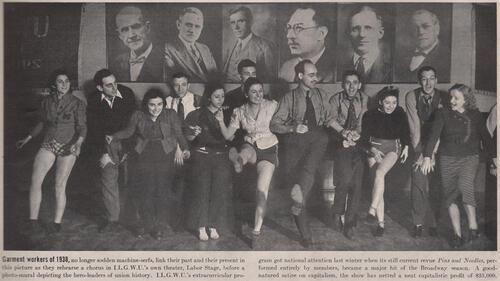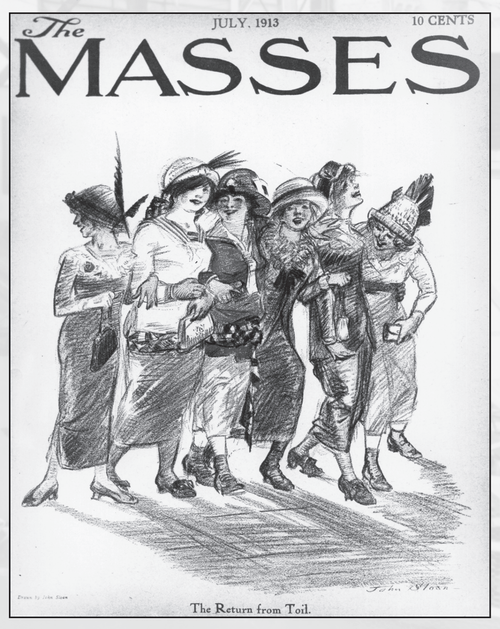Photo Activity
"Stop Your Cruel Oppression of the Jews" by Emil Flohri
Emil Flohri's political cartoon "USA to Russian Tsar: Stop Your Cruel Oppression of the Jews", published around 1904. Chromolithograph.
Courtesy of the U.S. Library of Congress.
Oppression in the Old Country
Jews who lived in Eastern Europe between 1881 and 1924 experienced extreme anti-Semitism and were persecuted by the government and their neighbors because of their religious beliefs. Many of these Jews immigrated to the United States in search of a better life and more opportunities. This print appeared after a 1903 pogrom in Kishinev, Russia.
pogrom: A violent riot aimed at massacre or persecution of an ethnic or religious group, particularly one aimed at Jews.
Shelter Us in the Shadow of Your Wings, 1901
Illustration regarding the Jewish immigrant experience in America: Shelter Us in the Shadow of Your Wings, copyright by Heb. Pub. Co. 1901.
Did They Find a Better Way of Life?
During this period, Jews in America had many freedoms which they had not experienced in their countries of origin. In the United States, Jewish immigrants found jobs and places to live—often with relatives or friends from their home countries. However, their new lives weren’t always what they had imagined.
A Visiting Nurse on Call
A visiting nurse on call assists a patient.
Courtesy of The Visiting Nurse Service of New York.
Uncomfortable and Unhealthy Living Conditions
Because of tight and often unhealthy living quarters, people became ill and needed the care of health professionals—doctors and nurses—who often visited them at home.
Backyard of the Henry Street Settlement
The Henry Street Settlement is a not–for–profit social service agency in the Lower East Side neighborhood of Manhattan, New York City that provides social services, arts programs, and health care services to New Yorkers of all ages. Here, immigrants could also pursue educational programs and learn English. Henry Street was one of many organizations—Jewish and secular—that helped immigrants find their way in their new home.
Sweatshop circa 1900
ACWA Archives, Kheel Center, Cornell University
Sweatshop Working Conditions
Many Jewish immigrants found work in the garment industry sewing clothes and coats or making hats. Garment workers often worked in their homes (or the homes of their employers), in cramped, hot, tenement apartments called sweatshops. This photograph of a tenement sweatshop is from around 1900.
Garment Factory circa 1910
Courtesy of ILGWU Archives, Kheel Center, Cornell University
Factory Working Conditions
As time went on and technology advanced, more and more workers sewed clothing in large factories. It was loud and crowded, and the hours were long with few or no breaks. Workers often had to pay for their own supplies (needles and thread) and were sometimes injured by the machines. Many of these factories also employed children and teenagers. Some of the money workers earned went towards food, lodging, and cultural activities, but much of it was sent overseas to help relatives living in their home countries.
Triangle Factory Owners Isaac Harris and Max Blanck
Courtesy of the International Ladies’ Garment Workers’ Union Archives, Kheel Center, Cornell University.
Jewish Factory Owners
The owners of these larger garment factories were often Jewish immigrants who had come to the United States 20 years earlier and managed to save up money to build their own businesses. In this picture, the Jewish owners of the Triangle Shirtwaist Co., Isaac Harris (front row, center, with hands folded) and Max Blanck (right of Harris), pose for a group photo, most likely with workers in their factory.
Garment Workers Rehearse a Chorus for ILGWU's Theater, Labor Stage
Garment workers of 1938, no longer sodden machine-serfs, link their past and their present in this picture as they rehearse a chorus in the I.L.G.W.U.'s own theater, Labor Stage, before a photo-mural depicting the hero-leaders of union history. I.L.G.W.U.'s extracurricular program got national attention last winter when its still current revue Pins and Needles, performed entirely by members, became a major hit of the Broadway season. A good-natured satire on capitalism, the show has netted a neat capitalistic profit of $35,000.
Photograph by Hansel Mieth in "ILGWU: A Great and Good Union Points the Way for America's Labor Movement," LIFE Magazine, August 1, 1938, 45.
Unions Not Just for Organizing
Labor unions helped workers organize and work together to get better wages, hours, and working conditions. Unions also provided important cultural benefits for their members including money for legal fees, educational services, cultural programming, and newspapers. In this picture, union members are rehearsing for a play in the union hall (their meeting place).
"The Return from Toil," July 1913
Courtesy of the U.S. Library of Congress.
The End of the Work Day
Though workers struggled with harsh conditions and low pay, they had opportunity and independence they couldn’t find in their home countries. Young women especially had more opportunities to work outside the home, to have an education, to have an independent social life, and to earn their own money. In fact, many young women were the main breadwinners in their households. The illustration below comes from the cover of a socialist magazine that was read by many of the workers in New York. It shows six women walking home from work.











